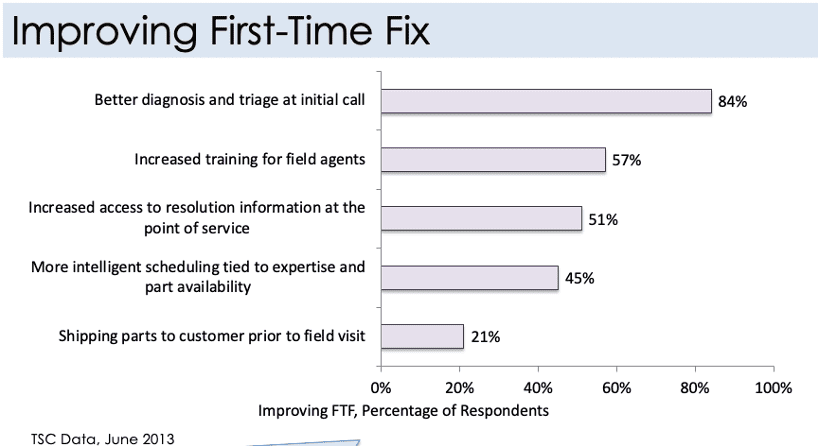In part one of this series, we established the impact of a low first-time fix rate on your business and customers. In part 2, we identified the five main buckets that affect first-time fix. In this final installment, we will look at the five focus areas where you can make improvements to bring your first-time fix to the optimum level for your business.
1. Spare Parts
Creating a partnership with your Supply Chain is the first step in improving all aspects that touch parts. You need to find common goals that will positively impact both division’s KPIs and allow the Supply Chain to actually be a supply chain rather than a demand chain. The first step is establishing a structured replenishment process for your technicians. Identify the right stocking levels that will ensure your technicians carry the correct parts to represent their installed base and skills. This allows schedulers to schedule the technicians with the most common spares for those products, improving the potential to successfully fix the issue on the first occasion. This also allows the supply chain to reduce backorders and lower the cost of shipping. Ensuring parts visibility is another important area so that technicians know what they have or are able to easily find the right part before visiting the customer’s site.
2. Skill Sets
Like visibility into spares, you need clear visibility into your technicians’ skill sets. But to be useful, these skill sets need to be tied to your installed base so that dispatchers instantly see the right technicians ranked for the service requests. When you understand the installed base you can be more effective in training the right technicians, and be more timely by training techs right before the installation of a new product in their region, rather than 12 months beforehand. You can also use reports to understand which technicians have a higher first-time fix than others, which have a longer mean time to repair than others, or if there are techs that try to fix machines with guesswork rather truly getting to the bottom of what is causing the issue.

3. White Space Management
White space management often comes down to what is perceived as a simple thing: mean time to repair (MTTR). Understanding MTTR and having it related to the product/fault allows a more accurate utilization of your technicians and the white space allowed. By looking at SLA agreements, skill sets, and MTTR, you can send the best technician at the best time for both the customer and the technician to ensure you meet expectations and reduce costs or risk of penalties. Managing this correctly also offers you upsell opportunity with increased response times, for example.
4. Incorrect Data
Data is easy to manage but incorrect data still happens all the time due to poor execution of internal processes or systems. Depending on the medium used for a customer to report the fault, there should be a process to double-check the standard information, serial number, address, and access hours to name a few. This information should be given to the customer for confirmation, rather than requested, as it should all be tied to the Installed Product in your system. Whenever these elements of data are incorrect, there should be a seamless process to change and validate. Many times, this is where the process fails as the data is managed in a separate system, but your service system should manage this data even if it is not the customer master.
5. Customer Issues
These happen too often and are generally absorbed into the business as goodwill, an unnecessary cost, and utilization of a valuable resource, especially when perceived to be covered by a maintenance contract. Customers are quite vocal about telling you when you have missed an SLA, failed to fix the equipment, delayed output, and so on. So why would you not tell the customer when they have caused you issues? If you can report these instances back to the customer in a setting such as a QBR where anecdotal information is replaced by factual data, you can have positive conversations and take actions for both yourself as the service provider and the customer to improve the customer’s experience and the performance of the asset. It becomes a win for both parties—a partnership.
These examples of solutions are some of the most impactful but are not a complete list. There are many other areas of focus that will reduce cost and improve customer satisfaction as well, such as remote fix. Additionally, things such as IoT, connected products, artificial intelligence, and augmented reality will all improve your ability to deliver excellent service. The points mentioned above are very simple to implement—some require analytics or changes in processes and working practices—but should be easy to adopt by any service business that has a service management system in place and the desire to make a change. The fundamental element is not the system and not how far you are into your digital transformation, but your desire to make a simple, intelligent change.
If you would like to talk to the ServiceMax Global Customer Transformation team to learn how they’ve improved first-time fix rates at their previous own organizations or helped ServiceMax customers do the same, reach out to us at .


Share this: